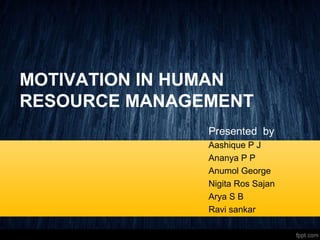
MOTIVATION IN HUMAN RESOURCE MANAGEMENT;
- 1. MOTIVATION IN HUMAN RESOURCE MANAGEMENT Presented by Aashique P J Ananya P P Anumol George Nigita Ros Sajan Arya S B Ravi sankar 1
- 2. Motivation Motivation is the internal and external factors that stimulate desire and energy in people to be continually interested and committed to a job, role or subject, or to make an effort to attain a goal. •Motivating people is about getting them to move in the direction which is required in order to achieve a result. •It is a goal directed behaviour. 2
- 3. According to Stephen P Robbins Motivation is “defined as the willingness to exert high levels of effort towards organizational goals” 3
- 4. Nature and Importance of Motivation Motivated employees Helps organization to survive Motivated employees are more productive Increases the output of the firm Approach of belongingness of the firm 4
- 5. Process of Motivation Need Establish goal Take action Attain goal 5
- 6. Process of motivation Needs creates wants and desires to achieve or obtain something Goals are established based on these desires and wants Actions are taken based on goals in order to attain it. If the goals are not achieved, the same action is likely to be repeated. This process of repeating successful behaviour or actions is called reinforcement or the aw of effect. 6
- 7. Types of Motivation Two types of Motivation identified by Herzberg et al (i) Intrinsic motivation (ii) Extrinsic motivation 7
- 8. Intrinsic motivation The self –generated factors that influence people to behave in a particular way or to move in a particular direction. These factors include responsibility, autonomy(freedom to act), scope to use and develop skill and abilities, interesting and challenging work and opportunities for advancement 8
- 9. Extrinsic motivation What is done to or for people to motivate them This includes rewards, such as increased pay, praise, or promotion, and punishments, such as disciplinary action, withholding pay, or criticism Extrinsic motivation can have an immediate and powerful effect, but it will not necessarily last long. 9
- 10. Motivation Theory The most influential theories of motivation are: (i) Maslow’s Need Hierarchy Theory (ii) Herzberg’s two factor model 10
- 11. (i) Maslow’s need hierarchy Abraham Maslow organized five major types of human needs into a hierarchy. The need hierarchy illustrates Maslow's conception of people satisfying their needs in a specified order, from bottom to top. 11
- 12. 12
- 13. Theory states that when a lower level need is satisfied, the next highest becomes dominant and the individual’s attention is turned to satisfying this higher need 13
- 14. (ii) Herzberg’s two factor theory Frederick Herzberg developed the two-factor theory of motivation based on satisfiers and dissatisfiers. Satisfiers are motivators associated with job satisfaction while dissatisfiers are motivators associated with hygiene or maintenance. Satisfiers include achievement, responsibility, advancement, and recognition 14
- 15. Satisfiers are all intrinsic motivators Dissatisfiers are extrinsic motivators and include a company’s policies and administration such as supervision, peers, working conditions, and salary. 15
- 16. The Two-Factor theory implies that the managers must stress upon guaranteeing the adequacy of the hygiene factors to avoid employee dissatisfaction The managers must make sure that the work is stimulating and rewarding so that the employees are motivated to work and perform harder and better 16
- 17. Methods for Motivating Employees a. Rewards: Employees constantly look for payoffs for their efforts. They expect that good job performance lead to organizational goal attainment, which in turn leads to satisfying their individual goals or needs. 17
- 18. b. Challenging Jobs: This is done through job enrichment. Job enrichment means building motivators like opportunities for achievement into the job by making it more interesting and challenging 18
- 19. c. Using Merit Pay: A merit raise is a salary increase, usually permanent, that is based on the employee's individual performance. It is a continuing increment rather than a single payment like a bonus. Relying heavily on merit rewards can be a problem because the reinforcement benefits of merit pay is usually only determined once per year19
- 20. d. Using Spot Awards: A spot award is one given to an employee as soon as the laudable performance is observed. These awards are consistent with principles of motivation because they are contingent on good performance and are awarded immediately 20
- 21. e. Using Skill-Based Pay With skill-based pay, employees are paid for the range, depth, and types of skills and knowledge they are capable of using rather than for the job the y currently hold The reward is a formal and concrete recognition that the person can do the more challenging job well. 21
- 22. In a nutshell….. What is motivation Nature and importance of motivation Process of motivation Types of motivation Theories of motivation Methods of motivation 22
- 23. 23